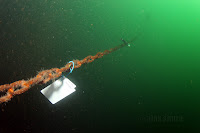Again we rode the line down to the break. I typically don't make it as far as the break when we moor on the stern. While many make the swim, you don't have much time to take in the scenery. The camera gear really adds a lot of drag and also contributes to my overall aversion to swimming while I'm 100 feet underwater.
As usual the deck was swarmed by thousands of cunner. Some of the larger ones on the wreck reach 8 or 9 inches, but most are half that size. These fish are abundant and generally unimpressed by the presence of divers.
Below, a sea raven showcases its camouflage while hanging on on a beam inside the break. I'm wondering if it's the same one we saw last week.

 Another resident found sanctuary inside a broken pipe. An impressive spot considering the pipe protruded about 10 feet off the sand and away from everything else. Also a brilliant hiding place considering she could back down as far as she wanted into the pipe evading capture by man or beast.
Another resident found sanctuary inside a broken pipe. An impressive spot considering the pipe protruded about 10 feet off the sand and away from everything else. Also a brilliant hiding place considering she could back down as far as she wanted into the pipe evading capture by man or beast.I generally don't see many of these acadian redfish while shore diving, but I almost always see one or two every time we dive the Poling. There's no doubt that the fish's vision is impressive due to the large eyes. Being red also helps it avoid detection in a place where there is very little red light. This particular fish was about 4 inches long.
Spanning the deck from the break towards the stern, there is a catwalk completely encrusted with invertebrates. Finger sponge, palmate sponge, breadcrumb sponge, frilled anemone, and colonies of hydroid are all clustered together competing for space. Midway down the catwalk there are some extremely sharp shards of metal bent upward. Needless to say, it's important to avoid contact with the catwalk and be aware of any currents that may push you into it.
Chuck decided to do a practice ascent using his pony bottle. We found out that even with our safety stops, the pony bottle would provide more than enough air to get us back to the surface. Chuck clips his 40cu.ft. bottle to his d-ring, I wear my 30cu.ft. bottle on my back to make space for hauling around my camera.




























